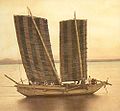Fishing vessel
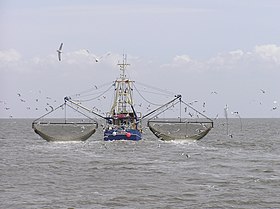

A fishing vessel is a
Prior to the 1950s there was little standardisation of fishing boats. Designs could vary between localities and even different
It is difficult to estimate the number of
History
Traditional fishing boats

Early fishing vessels included
The development of fishing boats took place in parallel with the development of boats for trade and war. Early navigators began to use animal skins or woven fabrics for sails. Affixed to a pole set upright in the boat, these sails gave early boats more range, allowing voyages of exploration.
Around 4000 B.C.,
At about the same time, the
By 1000 A.D. the Norsemen were pre-eminent on the oceans. They were skilled seamen and boat builders, with clinker-built boat designs that varied according to the type of boat. Trading boats, such as the knarrs, were wide to allow large cargo storage. Raiding boats, such as the longship, were long and narrow and very fast. The vessels they used for fishing were scaled down versions of their cargo boats. The Scandinavian innovations influenced fishing boat design long after the Viking period came to an end. For example, yoles from the Orkney Island of Stroma were built in the same way as the Norse boats.
Early modern designs
In the 15th century, the Dutch developed a type of seagoing
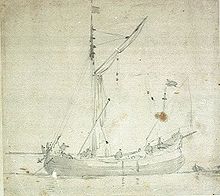
During the 17th century, the British developed the dogger, an early type of sailing trawler or longliner, which commonly operated in the North Sea.[6] Doggers were slow but sturdy, capable of fishing in the rough conditions of the North Sea.[7] Like the herring buss, they were wide-beamed and bluff-bowed, but considerably smaller, about 15 metres long, a maximum beam of 4.5 metres, a draught of 1.5 metres, and displacing about 13 tonnes. They could carry a tonne of bait, three tonnes of salt, half a tonne each of food and firewood for the crew, and return with six tonnes of fish.[7] Decked areas forward and aft probably provided accommodation, storage and a cooking area. An anchor would have allowed extended periods fishing in the same spot, in waters up to 18 metres deep. The dogger would also have carried a small open boat for maintaining lines and rowing ashore.[7]
A precursor to the
Modern fishing trawler


The Portuguese muletta and the British dogger were early types of sailing trawler in use before the 17th century and onward, but the modern fishing trawler was developed in the 19th century.
By the early 19th century, the fishermen at Brixham, needed to expand their fishing area further than ever before due to the ongoing depletion of stocks that was occurring in the overfished waters of South Devon. The Brixham trawler that evolved there was of a sleek build and had a tall gaff rig, which gave the vessel sufficient speed to make long-distance trips out to the fishing grounds in the ocean. They were also sufficiently robust to be able to tow large trawls in deep water. The great trawling fleet that built up at Brixham, earned the village the title of 'Mother of Deep-Sea Fisheries'.
This revolutionary design made large scale trawling in the ocean possible for the first time, resulting in a massive migration of fishermen from the ports in the South of England, to villages further north, such as Scarborough, Hull, Grimsby, Harwich and Yarmouth, that were points of access to the large fishing grounds in the Atlantic Ocean.
The small village of
The elegant Brixham trawler spread across the world, influencing fishing fleets everywhere. Their distinctive sails inspired the song Red Sails in the Sunset, written aboard a Brixham sailing trawler called the Torbay Lass.[14][15] By the end of the 19th century, there were over 3,000 fishing trawlers in commission in Britain, with almost 1,000 at Grimsby. These trawlers were sold to fishermen around Europe, including from the Netherlands and Scandinavia. Twelve trawlers went on to form the nucleus of the German fishing fleet.[16]
Although fishing vessel designed increasingly began to converge around the world, local conditions still often led the development of different types of fishing boats. The
Advent of steam power
The earliest steam powered fishing boats first appeared in the 1870s and used the
The earliest purpose built fishing vessels were designed and made by David Allan in
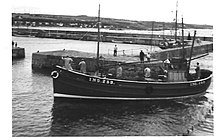
The first
Steam fishing boats had many advantages. They were usually about 20 ft longer (6.1 m) than the sailing vessels so they could carry more nets and catch more fish. This was important, as the market was growing quickly at the beginning of the 20th century. They could travel faster and further and with greater freedom from
Further development

Trawler designs adapted as the way they were powered changed from sail to coal-fired steam by
The first trawlers fished over the side, rather than over the stern. In 1947, the company Christian Salvesen, based in Leith, Scotland, refitted a surplus Algerine-class minesweeper (HMS Felicity) with refrigeration equipment and a factory ship stern ramp, to produce the first combined freezer/stern trawler in 1947.[18]
The first purpose-built stern trawler was Fairtry built in 1953 at
In recent decades, commercial fishing vessels have been increasingly equipped with electronic aids, such as
Global trends
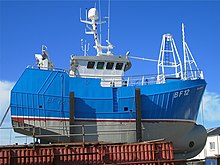

About 1.3 million of these are decked vessels with enclosed areas. Nearly all of these decked vessels are mechanised, and 40,000 of them are over 100 tons. At the other extreme, two-thirds (1.8 million) of the
The
Commercial vessels

The 200-mile fishing limit has changed fishing patterns and, in recent times, fishing boats are becoming more specialised and standardised. In the United States and Canada more use is made of large factory trawlers, while the huge blue water fleets operated by Japan and the Soviet-bloc countries have contracted. In western Europe, fishing vessel design is focused on compact boats with high catching power.
Commercial fishing is a high risk industry, and countries are introducing regulations governing the construction and operation of fishing vessels. The International Maritime Organization, convened in 1959 by the United Nations, is responsible for devising measures aimed at the prevention of accidents, including standards for ship design, construction, equipment, operation and manning.
According to the
Commercial fishing vessels can be classified by architecture, the type of fish they catch, the fishing method used, or geographical origin. The following classification follows the FAO,[21] who classify commercial fishing vessels by the gear they use.
Fishing gear
-
Drum winches mounted at the stern of an Irish trawler
Trawlers
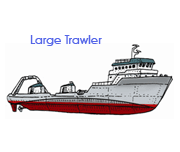
A
- Outrigger trawlers – use outriggers to tow the trawl. These are commonly used to catch shrimp. One or two otter trawls can be towed from each side. Beam trawlers, employed in the North sea for catching flatfish, are another form of outrigger trawler. Medium-sized and high powered vessels, these tow a beam trawl on each side at speeds up to 8 knots.[23]
- Beam trawlers – use sturdy outrigger booms for towing a beam trawl, one warp on each side. Double-rig beam trawlers can tow a separate trawl on each side of the trawler. Beam trawling is used in the flatfish and shrimp fisheries in the North Sea. They are medium-sized and high powered vessels, towing gear at speeds up to 8 knots. To avoid the boat capsizing if the trawl snags on the sea floor, winch brakes can be installed, along with safety release systems in the boom stays. The engine power of bottom trawlers is also restricted to 2000 HP (1472 KW) for further safety.[24]
- otter boards. These trawls can be towed in midwater or along the bottom.[25]
- Pair trawlers – are trawlers which operate together towing a single trawl. They keep the trawl open horizontally by keeping their distance when towing. Otter boards are not used. Pair trawlers operate both midwater and bottom trawls.[26]
- Side trawlers – have the trawl set over the side with the trawl warps passing through blocks which hang from two gallows, one forward and one aft. Until the late sixties, side trawlers were the most familiar vessel in the North Atlantic deep sea fisheries. They evolved over a longer period than other trawler types, but are now being replaced by stern trawlers.[27]
- pelagic and small stern trawlers are often designed without a ramp. Stern trawlers are designed to operate in most weather conditions. They can work alone when midwater or bottom trawling, or two can work together as pair trawlers.[28]
- Freezer trawlers – The majority of trawlers operating on high sea waters are freezer trawlers. They have facilities for preserving fish by freezing, allowing them to stay at sea for extended periods of time. They are medium to large size trawlers, with the same general arrangement as stern or side trawlers.[29]
- Wet fish trawlers – are trawlers where the fish is kept in the hold in a fresh/wet condition. They must operate in areas not far distant from their landing place, and the fishing time of such vessels is limited.[30]
Seiners
- Purse seiners are very effective at targeting bow thrusters for better manoeuvrability. Then the bottom of the net is pursed (closed) underneath the fish shoal by hauling a wire running from the vessel through rings along the bottom of the net and then back to the vessel. The most important part of the fishing operation is searching for the fish shoals and assessing their size and direction of movement. Sophisticated electronics, such as echosounders, sonar, and track plotters, may be used are used to search for and track schools; assessing their size and movement and keeping in touch with the school while it is surrounded with the seine net. Crows nests may be built on the masts for further visual support. Large vessels can have observation towers and helicopter landing decks. Helicopters and spotter planes are used for detecting fish schools. The main types of purse seiners are the American seiners, the European seiners and the Drum seiners.[33]
- American seiners have their bridge and accommodation placed forward with the working deck aft. American seiners are most common on both coasts of North America and in other areas of Oceania. The net is stowed at the stern and is set over the stern. The power block is usually attached to a boom from a mast located behind the superstructure. American seiners use Triplerollers.[34] A purse line winch is located amidships near the hauling station, near the side where the rings are taken on board.[32]
- European seiners have their bridge and accommodation located more to the after part of the vessel with the working deck amidships. European seiners are most common in waters fished by European nations. The net is stowed in a net bin at the stern, and is set over the stern from this position. The pursing winch is normally positioned at the forward part of the working deck.[35]
- Drum seiners have the same layout as American seiners except a drum is mounted on the stern and used instead of the power block. They are mainly used in Canada and USA.[36]
- Tuna purse seiners are large purse seiners, normally over 45 metres, equipped to handle large and heavy purse seines for tuna. They have the same general arrangement as the American seiner, with the bridge and accommodation placed forward. A crows nest or tuna tower is positioned at the top of the mast, outfitted with the control and manoeuvre devices. A very heavy boom which carries the power block is fitted at the mast. They often carry a helicopter to search for tuna schools. On the deck are three drum purse seine winches and a power block, with other specific winches to handle the heavy boom and net. They are usually equipped with a skiff.[37]
- Seine netters - the basic types of seine netters are the anchor seiners and Scottish seiner in northern Europe and the Asian seiners in Asia.[38]
- Anchor seiners have the wheelhouse and accommodation aft and the working deck amidships, thus resembling side trawlers. The seine net is stored and shot from the stern, and they may carry a power block. Anchor seiners have the coiler and winch mounted transversally amidships.[38]
- Scottish seiners are basically configured the same as anchor seiners. The only difference is that, whereas the anchor seiner has the coiler and winch mounted transversally amidships, the Scottish seiner has them mounted transversally in the forward part of the vessel.[38]
- Asian seiners – In Asia, the seine netter usually has the wheelhouse forward and the working deck aft, in the manner of a stern trawler. However, in regions where the fishing effort is a labour-intensive, low-technology approach, they are often undecked and may be powered by outboards motors, or even by sail.[38]
-
Purse seiner
-
Large purse seiner
-
Spanish tuna purse seiner, Albatun Dos, near Victoria, Seychelles
Line vessels
Line vessels –
- hooks hanging from the main line by means of branch lines called "snoods". Hand operated longlining can be operated from boats of any size. The number of hooks and lines handled depends on the size of vessel, the number of crew, and the level of mechanisation. Large purpose built longliners can be designed for single species fisheries such as tuna. On such larger vessels the bridge is usually placed aft, and the gear is hauled from the bow or from the side with mechanical or hydraulic line haulers. The lines are set over the stern. Automatic or semi-automatic systems are used to bait hooks and shoot and haul lines. These systems include rail rollers, line haulers, hook separators, dehookers and hook cleaners, and storage racks or drums. To avoid incidental catches of seabirds, an outboard setting funnel is used to guide the line from the setting position on the stern down to a depth of one or two metres. Small scale longliners handle the gear by hand. The line is stored into baskets or tubs, perhaps using a hand cranked line drum.[39]
- Bottom longliners – [40]
- Midwater longliners – are usually medium-sized vessels which operate worldwide, purpose built to catch large pelagics. The line hauler is usually forward starboard, where the fish are hauled through a gate in the rail. The lines are set from the stern where a baiting table and chute are located. These boats need adequate speed to reach distant fishing grounds, enough endurance for continued fishing, adequate freezing storage, suitable mechanisms for shooting and hauling longlines quickly, and proper storage for fishing gears and accessories.[41]
- Freezer longliners – are outfitted with freezing equipment. The holds are insulated and refrigerated. Freezer longliners are medium to large with the same general characteristics of other longliners. Most longliners operating on the high seas are freezer longliners.[42]
- high seas with the same general characteristics of other large longliners.[43]
- Wet-fish longliners – keep the caught fish in the hold in the fresh/wet condition. The fish is stored in boxes and covered with ice, or stored with ice in the fish hold. The fishing time of such vessels is limited, so they operate close to the landing place.[44]
| External image | |
|---|---|
- Pole and line vessels – are used mainly to catch hooks which are baited, preferably with live bait. Caught tuna are swung on board, by two to three fishermen if the tuna is big, or with an automated swinging mechanism. The tuna usually release themselves from the barbless hook when they hit the deck. Tanks with live bait are placed round the decks, and water spray systems are used to attract the fish. The vessels are 15 to 45 metres o/a. On smaller vessels fishers fish from the main deck right around the boat. With larger vessels, there are two different deck styles: the American style and the Japanese style.[45]
- American style – fishers stand on platforms arranged over the side abaft amidships and around the stern. The vessel moves ahead during fishing operation.[45]"Drawing". FAO.
- Japanese style – fishers stand at the rail in the forepart of the vessel. The vessel drifts during fishing operations.[45]"Drawing". FAO.
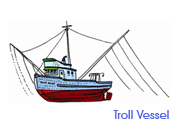
- pelagic fish swimming close to the surface. Purpose-built trollers are usually equipped with two or four trolling booms raised and lowered by topping lifts, held in position by adjustable stays. Electrically powered or hydraulic reels can be used to haul in the lines.[46]
- Jiggers – there are two types of jiggers: specialised squid jiggers which work mostly in the southern hemisphere and smaller vessels using jigging techniques in the northern hemisphere mainly for catching cod.[47]
- Squid jiggers – have single or double drum jigger winches lined along the rails around the vessel. Strong lamps, up to 5000 W each, are used to attract the squid. These are arranged 50–60 centimetres apart, either as one row in the centre of the vessel, or two rows, one on each side. As the squid are caught they are transferred by chutes to the processing plant of the vessel. The jigging motion can be produced mechanically by the shape of the drum or electronically by adjustment to the winch motor. Squid jiggers are often used during the day as midwater trawlers and during the night as jiggers.[47]
- Cod jiggers – use single jigger machines and do not use lights to attract the fish. The fish are attracted by the jigging motion and artificial bait.[47]
Other vessels
- molluscs from the seafloor. There are three types of dredges: (a) The dredge can be dragged along the seabed, scooping the shellfish from the ground. These dredges are towed in a manner similar to beam trawlers, and large dredgers can work three or more dredges on each side. (b) Heavy mechanical dredging units are operated by special gallows from the bow of the vessel. (c) The dredger employs a hydraulic dredge which uses a powerful water pump to operates water jets which flush the molluscs from the bottom. Dredgers don't have a typical deck arrangement, the bridge and accommodation can be aft or forward. Derricks and winches may be installed for lowering and lifting the dredge. Echosounders are used for determining depths.[48]
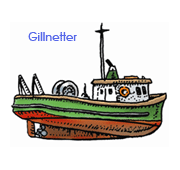
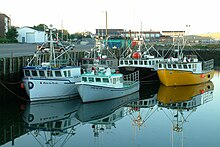


- Gillnetters – On inland waters and inshore, high seas, medium-sized vessels using drifting gillnets are called drifters, and the bridge is usually located aft. The nets are set and hauled by hand on small open boats. Larger boats use hydraulic or occasionally mechanical net haulers, or net drums. These vessels can be equipped with an echosounder, although locating fish is more a matter of the fishermen's personal knowledge of the fishing grounds rather than depending on special detection equipment.[49]
- Set netters – also operate gillnets. However, during fishing operations the vessel is not attached to the nets. The size of the vessels varies from open boats to large specialised drifters operating on the high seas. The wheelhouse is usually located aft, and the front deck is used for handling gear. Normally the nets are set at the stern by steaming ahead. Hauling is done over the side at the forepart of the deck, usually using hydraulic driven net haulers. Wet fish is packed in containers chilled with ice. Larger vessels might freeze the catch.[50]
- Set netters – also operate gillnets. However, during fishing operations the vessel is not attached to the nets. The size of the vessels varies from open boats to large specialised drifters operating on the
- Lift netters – are equipped to operate lift nets, which are held from the vessel's side and raised and lowered by means of outriggers. Lift netters range from open boats about 10 metres long to larger vessels with open ocean capability. Decked vessels usually have the bridge amidships. Larger vessels are often equipped with winches and derricks for handling the lifting lines, as well as outriggers and light booms. They can be fitted with powerful lights to attract and aggregate the fish to the surface. Open boats are usually unmechanized or use hand-operated winches. Electronic equipment, such as echo sounders are used extensively on larger boats.[51]
- Trap setters – are used to set pots or traps for catching fish, crabs, lobsters, crayfish and other similar species. Trap setters range in size from open boats operating inshore to larger decked vessels, 20 to 50 metres long, operating out to the edge of the continental shelf. Small decked trap setters have the wheelhouse either forward or aft with the fish hold amidships. They use hydraulic or mechanical pot haulers. Larger vessels have the wheelhouse forward, and are equipped with derricks, davits or cranes for hauling pots aboard. Locating fish is often more a matter of the fishermen's knowledge of the fishing grounds rather than the use of special detection equipment. Decked vessels are usually equipped with an echosounder, and large vessels may also have a Loran or GPS.[52]
- o/a, and do not have special gear handling, there is no winch or gurdy. Locating fish is left to the fishermen's personal knowledge of fishing grounds rather than the use of special electronic equipment. Non traditional handliners can set and haul using electrical or hydraulic powered reels. These mechanised reels are normally fastened to the gunwale or set on stanchions close to or overhanging the gunwale. They operate all over the world, some in shallow waters, some fishing up to 300 metres deep. No typical deck arrangement exists for handliners.[53]
- Multipurpose vessels – are vessels which are designed so they can deploy more than one type of fishing gear without major modifications to the vessels. The fish detection equipment present on board also changes according to which fishing gear is being used.[54]
- Trawler/Purse seiners – are designed so the deck arrangement and equipment, including a suitable combination winch, can be used for both methods. Rollers, blocks, trawl gallows and purse davits need to be arranged so they control the lead of warps and pursing lines in such a way as to reduce the time needed to convert from one type to the other. Typical fish detection equipment includes a sonar and an echosounder. These vessels are usually designed as trawlers, since the power requirement for trawling is higher.[55]
- Research vessels – a fisheries research vessel (FRV) requires platforms which are capable of towing different types of fishing nets, collecting plankton or water samples from a range of depths, and carrying acoustic fish-finding equipment. Fisheries research vessels are often designed and built along the same lines as a large fishing vessel, but with space given over to laboratories and equipment storage, as opposed to storage of the catch. An example of a fisheries research vessel is FRV Scotia.
Artisan vessels
According to the
These figures for small fishing vessels are probably under reported. The
-
Fisherman landing his catch in the Seychelles.
-
Indian split-log fishing canoe
-
Fishing boats in Gambia.
-
Traditional Vietnamese fishing boat
-
Fishing junk, 1871
Artisan fishing boats are usually small
-
A smallbasniganwith the characteristic poles used for anchoring nets and holding gas-powered lamps for attracting fish
-
Indian clinker fishing boats
-
Traditional Philippine fishingoutrigger canoes(bangka)
Recreational vessels

Recreational fishing is done for
It is difficult to estimate how many recreational fishing boats there are, although the number is high. The term is fluid, since most recreational boats are also used for fishing from time to time. Unlike most commercial fishing vessels, recreational fishing boats are often not dedicated just to fishing, but also other
.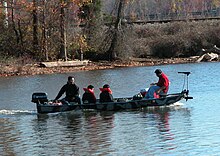
- Fishing kayaks have gained popularity in recent years. The kayak has long been a means of accessing fishing grounds.
- white water raftingindustry.
- GPS navigation.
- Charter boats are often privately operated, purpose-built fishing boats, and host guided fishing trips for paying clients. Their size can range widely depending on the type of trips run and the geographical location.
- Freshwater fishing boats account for approximately one third of all registered boats in the USA. Most other types of boats end up being used for fishing on occasion.
- Saltwater fishing boats vary widely in size and can be specialized for certain species of fish. Flounder boats, for example, have flat bottoms for a shallow draft and are used in protected, shallow waters. Sport fishing boats range from 25 to 80 feet or more, and can be powered by large outboard engines or inboard diesels. Boats used for fishing in cold climates may have space dedicated to a cuddy cabinor enclosed wheelhouse, while boats in warmer climates are more likely to be open.
-
Fly fishing from a dinghy
-
Small sport fishing boat
-
A larger charterbig game rig in Bermuda.
See also
- Factory ship
- Maritime history of the United Kingdom
- Shetland bus boats
- Traditional fishing boat
- Western Flyer (boat)
Notes
- ^ a b McGrail 2001, page 431
- ^ "Oldest Boat Unearthed". China.org.cn. Archived from the original on 2009-01-02. Retrieved 2008-05-05.
- S2CID 36178755. Retrieved 2008-05-05.
- ^ a b c Ward, Cheryl (May–June 2001). "World's Oldest Planked Boats". Archaeology. 54 (3).
- ^ De Vries & Woude (1977), pages 244–245
- ^ Oxford Companion to Ships and the Sea, p. 256
- ^ a b c Fagan 2008
- ^ Gardner 1987, page 18
- ^ Gardner 1987, page 15
- ^ a b Chapelle, page 85
- ^ Grimsby heyday of the 'three-day millionaire' BBC, 15 November 2012
- ^ "A brief history of Grimsby". localhistories.org. 14 March 2021.
- ^ "Great Grimsby". UK Genealogy Archives.
- ^ "History of a Brixham trawler". JKappeal.org. 2 March 2009. Archived from the original on 2 December 2010. Retrieved 13 September 2010.
- ^ "Pilgrim's restoration under full sail". BBC. Retrieved 2 March 2009.
- ^ Sailing trawlers. 10 January 2014.
- ^ a b c "The Steam Trawler".
- ^ a b "HISTORY". Archived from the original on 2013-08-21. Retrieved 2015-07-05.
- ^ a b c d e FAO 2007
- ^ "2012 Cape Town Agreement to enhance fishing safety". International Maritime Organization. Retrieved 1 November 2022.
- FAO.
- ^ "Fishing Vessel type: Trawlers". FAO.
- ^ "Fishing Vessel type: Outrigger trawlers". FAO. "Drawing". FAO. Archived from the original on 2015-09-24. Retrieved 2009-01-31.
- ^ "Fishing Vessel type: Beam trawlers". FAO. "Drawing". FAO. Archived from the original on 2015-09-24. Retrieved 2009-01-31.
- ^ "Fishing Vessel type: Otter trawlers". FAO.
- ^ "Fishing Vessel type: Pair trawlers". FAO.
- ^ "Fishing Vessel type: Side trawlers". FAO."Drawing". FAO. Archived from the original on 2012-10-21. Retrieved 2009-01-31.
- ^ "Fishing Vessel type: Stern trawlers". FAO. "Drawing". FAO. Archived from the original on 2015-09-24. Retrieved 2009-01-31.
- ^ "Fishing Vessel type: Freezer trawlers". FAO. "Drawing". FAO. Archived from the original on 2016-03-03. Retrieved 2009-01-31.
- ^ "Fishing Vessel type: Wet-fish trawlers". FAO. "Drawing". FAO. Archived from the original on 2012-10-21. Retrieved 2009-01-31.
- ^ "Fishing Vessel type: Seiners". FAO.
- ^ a b "Fishing Vessel type: American seiners". FAO. "Drawing". FAO. Archived from the original on 2015-09-24. Retrieved 2009-01-31.
- ^ "Fishing Vessel type: Purse seiner". FAO.
- ^ "Fishery equipment: Tripleroller". FAO.
- ^ "Fishing Vessel type: European seiners". FAO. "Drawing". FAO. Archived from the original on 2015-09-24. Retrieved 2009-01-31.
- ^ "Fishing Vessel type: Drum seiners". FAO. "Drawing". FAO. Archived from the original on 2015-09-24. Retrieved 2009-01-31.
- ^ "Fishing Vessel type: Tuna Purse seiners". FAO. "Drawing". FAO. Archived from the original on 2015-09-24. Retrieved 2009-01-31.
- ^ a b c d "Fishing Vessel type: [Seine netters". FAO. "Drawing". FAO. Archived from the original on 2015-09-24. Retrieved 2009-01-31.
- ^ "Fishing Vessel type: Longliners". FAO. "Drawing". FAO. Archived from the original on 2015-09-24. Retrieved 2009-01-31.
- ^ "Fishing Vessel type: Bottom longliners". FAO.
- ^ "Fishing Vessel type: Midwater longliners". FAO.
- ^ "Fishing Vessel type: Freezer longliners". FAO.
- ^ "Fishing Vessel type: Factory longliners". FAO.
- ^ "Fishing Vessel type: Wet-fish longliners". FAO.
- ^ a b c "Fishing Vessel type: Pole and line vessels". FAO.
- ^ "Fishing Vessel type: Trawler". FAO. "Drawing". FAO. Archived from the original on 2015-09-24. Retrieved 2009-01-31.
- ^ a b c "Fishing Vessel type: Jigger vessels". FAO.
- ^ "Fishing Vessel type: Dredgers". FAO. "Drawing". FAO. Archived from the original on 2015-09-24. Retrieved 2009-01-31.
- ^ "Fishing Vessel type: Gillnetters". FAO. "Drawing". FAO. Archived from the original on 2015-09-24. Retrieved 2009-01-31.
- ^ "Fishing Vessel type: Set netters". FAO.
- ^ "Fishing Vessel type: Lift netters". FAO."Drawing". FAO. Archived from the original on 2012-10-21. Retrieved 2009-01-31.
- ^ "Fishing Vessel type: Trap setters". FAO.
- ^ "Fishing Vessel type: Handliners". FAO.
- ^ "Fishing Vessel type: Multipurpose vessels". FAO.
- ^ "Fishing Vessel type: Trawler-purse seiners". FAO.
- ^ "Country Profile: Indonesia". FAO.
- ^ "Country Profile: Philippines". FAO.
- NOAA: Sport fishing boat
- ^ "The history of game fishing". Boot.de. Archived from the original on 2016-04-03. Retrieved 2009-05-05.
- ^ "First game fishing boat arrives in Hawaii". Honolulu Star-Bulletin. 13 March 1916. Archived from the original on 19 July 2011.
References
- Chapelle, Howard L. (1951) American Small Sailing Craft WW Norton Company, New York, ISBN 0-393-03143-8
- Fagan, Brian (2008) The Great Warming. Chapter 10: Bucking the trades Bloomsbury Press. ISBN 978-1-59691-392-9
- FAO: Fisheries technology: Fishing vesselsRetrieved 2 February 2009.
- FAO: CWP Handbook of Fishery Statistical Standards : Section L: Fishery Fleet
- ] FAO Fisheries Circular C949.
- ISBN 978-92-5-105568-7
- Gardner, John (1987) The Dory Book. Mystic Seaport Museum, Mystic Connecticut. ISBN 0-913372-44-7
- McGrail, Sean (2004). Boats of the World: From the Stone Age to Medieval Times. USA: Oxford University Press. ISBN 0-19-927186-0.
- Vries, J. de, and Woude, A. van der (1997), The First Modern Economy. Success, Failure, and Perseverance of the Dutch Economy, 1500-1815, ISBN 978-0-521-57825-7
Further reading
- Gerr, Dave (1995) The Nature of Boats: Insights and Esoterica for the Nautically Obsessed McGraw-Hill Professional. ISBN 978-0-07-024233-3
- Smylie, Michael (1999) Traditional Fishing Boats of Britain & Ireland: Design, History and Evolution. Adlard Coles Nautical. ISBN 978-1-84037-035-5
- Traung, Jan-Olaf (1960) Fishing Boats of the World 2 Fishing News (Books) Ltd., Download PDF (99MB)
- Traung, Jan-Olaf (1967) Fishing Boats of the World 3 Kiefer Press.
- Vigor, John (2004) The Practical Encyclopedia of Boating: An A-Z Compendium of Seamanship, Boat Maintenance, Navigation, and Nautical Wisdom McGraw-Hill Professional. ISBN 978-0-07-137885-7
- Fishing vessels History.comEncyclopedia. Retrieved 14 September 2009.
External links
- FAO Fishing Vessels Finder Archived 2013-01-31 at the Wayback Machine, FAO public database of fishing vessels, includes data from different sources and allows searching vessel data by many different criteria












